Training your delts is a critical part of strengthening and framing your shoulders. Whether you are a training fanatic or creating your first training plan, the exercises below will help you meet your fitness goals.
resistance band seated shoulder press
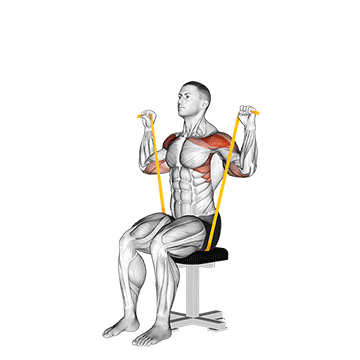
1. Begin by sitting down on a flat bench or chair with your feet flat on the floor, shoulder-width apart.
2. Place the resistance band under your feet, ensuring it's centered so that each end is an equal length.
3. Hold the ends of the resistance band in each hand. Your hands should be at shoulder level with your palms facing forward. This is your starting position.
4. Press your hands upward until your arms are fully extended, keeping your back straight and your core engaged. Ensure that you are pushing directly upwards, not outwards or inwards.
5. Pause for a moment at the top of the movement, then slowly lower your hands back down to the starting position.
6. Repeat this movement for your desired number of repetitions.
Remember to keep your movements controlled, don't let the band snap back quickly. The resistance should be felt in your deltoid muscles, located in your shoulders. If the exercise feels too easy, you can increase the resistance by either shortening the band or using a band with a higher resistance level. If it's too hard, do the opposite.
band y-raise
To perform the band Y-raise, follow these steps:
1. Stand upright with your feet shoulder-width apart. Hold the band with both hands, palms facing each other. Make sure the band is of appropriate resistance - not too easy, but not so hard that you can't complete the exercise with proper form.
2. Extend your arms straight down in front of you so that the band is taut. This is your starting position.
3. Slowly raise your arms up and out to the sides in a Y shape, keeping your arms straight. The band should be stretched as you do this. Make sure to squeeze your shoulder blades together as you lift.
4. Hold this position for a moment, feeling the tension in your delts.
5. Slowly lower your arms back to the starting position, maintaining control of the band at all times.
6. Repeat this movement for your desired number of repetitions.
Remember to keep your core engaged and your back straight throughout the exercise. Avoid using your body to swing or jerk the band up, as this can lead to injury and won't effectively target your delts. The movement should be controlled and deliberate, focusing on the muscle contraction and release.
band twisting overhead press
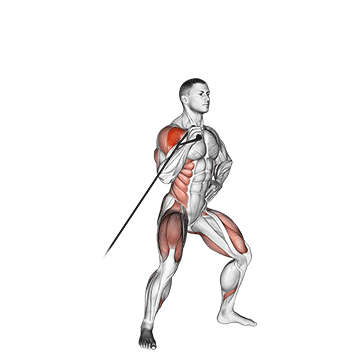
To perform the band twisting overhead press, start by standing upright with your feet shoulder-width apart. Hold the band with both hands, palms facing each other, at shoulder level.
Next, twist your hands so that your palms are facing forward. This is your starting position.
Now, press the band overhead by extending your arms straight up. Ensure that your wrists are directly above your shoulders at the top of the movement.
Pause for a moment at the top, then slowly lower the band back to the starting position, reversing the twist in your hands as you do so.
Remember to keep your core engaged and your back straight throughout the exercise.
Repeat this movement for the desired number of repetitions. This exercise primarily targets the deltoid muscles in your shoulders.
Ensure to choose a band with a resistance level that allows you to complete the exercise with proper form. If the band is too heavy, it may lead to improper form and potential injury. If it's too light, you may not effectively engage your deltoid muscles.
band standing rear delt row
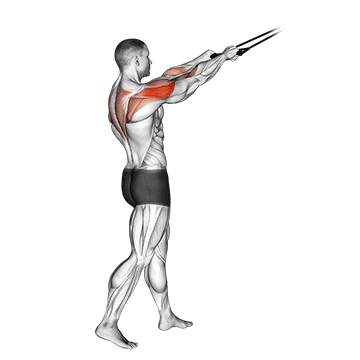
To perform the band standing rear delt row, start by standing upright with your feet shoulder-width apart. Hold the band in both hands, ensuring it is taut but not overly stretched.
Extend your arms straight out in front of you at shoulder height. This is your starting position.
Engage your core and pull the band apart by drawing your elbows back towards your body. Keep your elbows bent at a 90-degree angle as you pull the band apart.
Squeeze your shoulder blades together as you pull the band apart. Ensure your shoulders are down and back, not creeping up towards your ears.
Hold this position for a moment, feeling the contraction in your rear delts.
Slowly return to the starting position, controlling the movement of the band.
Repeat this exercise for the desired number of repetitions.
Remember to keep your back straight and your movements controlled throughout the exercise. Avoid using your body momentum to pull the band apart; instead, focus on using your rear delt muscles.
This exercise can be adjusted to increase or decrease resistance by changing the tension on the band. The tighter the band, the more challenging the exercise will be.
band shoulder press
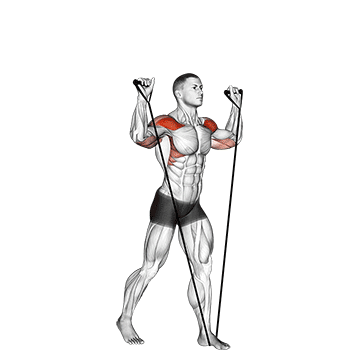
To perform the band shoulder press, start by standing on the center of your resistance band with your feet shoulder-width apart. Hold the ends of the band in each hand at shoulder level, with your palms facing forward.
Next, press your hands upward until your arms are fully extended above your head. Ensure that you're pushing straight up and not outwards or inwards to target your deltoids effectively.
Pause for a moment at the top of the movement, then slowly lower your hands back down to shoulder level. This completes one repetition.
Remember to keep your core engaged and your back straight throughout the exercise to maintain proper form and prevent injury. Adjust the tension of the band as needed to suit your strength level.
Repeat this exercise for your desired number of repetitions or until you feel a good burn in your deltoids.
band reverse fly
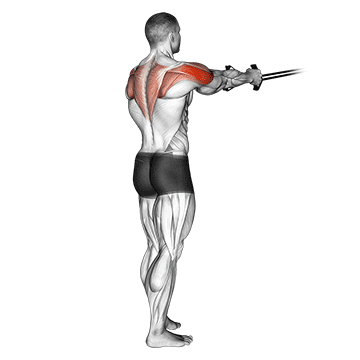
To perform the band reverse fly, start by standing tall with your feet shoulder-width apart. Hold the band in front of you at chest height with your arms fully extended. Ensure that your hands are shoulder-width apart and that there is tension in the band.
Next, pull the band apart by squeezing your shoulder blades together and moving your hands out to the sides. Keep your arms straight and your wrists neutral throughout the movement. You should feel a contraction in your delts as you pull the band apart.
Slowly return your hands to the starting position, maintaining tension in the band. This completes one repetition. Aim for 3 sets of 10-15 repetitions, ensuring to keep your movements slow and controlled to maximize muscle engagement.
Remember to keep your core engaged and your back straight throughout the exercise to protect your spine. If the exercise feels too easy, you can increase the difficulty by using a band with more resistance or by widening your grip on the band.
band front raise
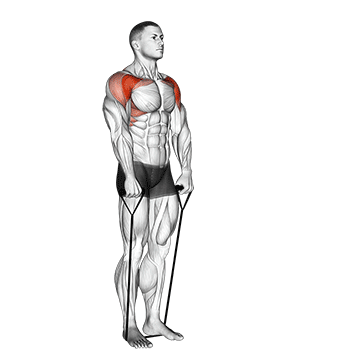
To perform the band front raise, start by standing on the center of your resistance band with your feet shoulder-width apart. Hold the ends of the band in each hand, palms facing towards your body.
Ensure your back is straight, your core is engaged, and your gaze is forward. This is your starting position.
Slowly raise your arms straight out in front of you until they are at shoulder height, keeping a slight bend in your elbows to avoid locking them. As you lift, the band will stretch, providing resistance. Make sure your wrists are in line with your arms, not bent.
Pause for a moment at the top of the movement, then slowly lower your arms back down to the starting position.
Remember to keep your movements controlled, resisting the pull of the band as you lower your arms. This ensures your muscles are engaged throughout the entire exercise.
Repeat this movement for your desired number of repetitions. This exercise primarily targets the deltoid muscles in your shoulders.
Remember to choose a band with a resistance level that allows you to complete the exercise with proper form, but still provides a challenge. As you get stronger, you can increase the resistance.
band front lateral raise
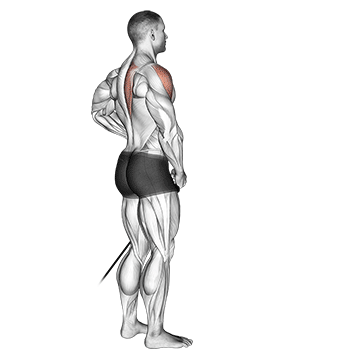
To perform the band front lateral raise, start by standing upright with your feet shoulder-width apart. Place the band under both feet to secure it in place.
Hold the ends of the band in each hand with your palms facing towards your body. Your hands should be slightly less than shoulder-width apart. This is your starting position.
Slowly raise your arms up in front of you until they are parallel to the floor, keeping a slight bend in your elbows. Ensure that your wrists remain in a neutral position and that you are lifting the band using your delts, not your hands.
Pause for a moment at the top of the movement, then slowly lower your arms back down to the starting position.
Ensure that you maintain tension in the band throughout the entire movement. Do not let the band snap back quickly, but control the descent.
Repeat this movement for your desired number of repetitions.
Remember to keep your core engaged and your back straight throughout the exercise to protect your spine and maximize the effectiveness of the exercise.
This exercise primarily targets the deltoids, but also works the upper back and core. Adjust the resistance of the band as needed to suit your strength levels.
No tags for this post.
